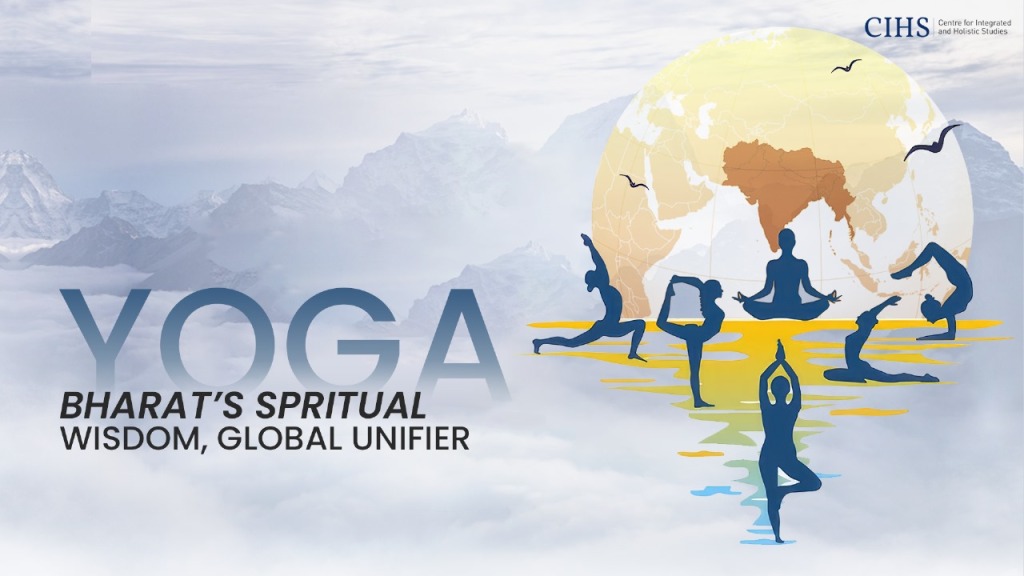Happy soul, fresh mind and a healthy body – all three can be achieved with yoga!
Dr Aniruddh Subhedar
On June 21 last year when Prime Minister Narendra Modi led ninth International Yoga Day celebrations at United Nations headquarters in New York, it marked a significant shift in Bharat’s global image- from being seen as a “backward third world country of snake charmers” to a leader in philosophical and spiritual pursuits for the global communities.

Bharat’s wisdom has contributed big to global order for millennia. And, today, it has so much more to offer through yoga, Ayurveda, alternative life styles in sync with environment. And, it’s only natural that Yoga has become its most popular and globally accepted brand ambassador. Yoga, by its very nature, has a universal appeal and application that puts individuals on path of spiritual self-realization as well as physical well-being.
What is Yoga?
Yoga is identified with various asanas (postures) and physical exercises which is just a small aspect of the entire scientific offer. Yogic philosophy is part of six orthodox Indian schools of thought, alongside Nyaya, Vaisheshika, Mimamsa, Samkhya, and Vedanta. These are called Astika darshanas as they all consider Vedas as the authority.
Each offers a unique perspective to the world of spirituality and interpretation of the Vedas, the fountainhead of Indian civilization. What makes Yoga different and popular is its relevance to both the masses and elite. It’s in Mimamsa and Nyaya that we find deepest and intellectually rigorous philosophical musings.
Yoga, on the other hand, reaches spiritual heights as any other darshan or vision while offering practical applications accessible to everyone and asanas are its most popular form.
Worldwide, yoga is practised today is just a set of physical and breathing exercises. Those that delve deeper into practicing Yoga follow higher levels such as dhyana or meditation that can rightly be called India’s gift to the world. The word “Yoga” means “to add” or “to unify”. Yoga teaches union of individual consciousness thereby forging perfect harmony between mind and body, human being and nature.
As Maharshi Patanjali propounded in his ‘Yoga Sutra’ योगश्चित्तवृत्तिनिरोधः (Yoga controls fluctuations / wanderings of the mind). Yoga trains a person to regulate one’s mind, thoughts and achieving spiritual heights that Bhakti saints describe as “unification with God.” Physical fitness is just first step in this noble endeavour, ultimate goal is unification.
This higher goal is achieved through forms of meditation, guiding a person to self-realization. Meditation is not only significant to the Vedic lifestyle but central to non-Vedic Buddhist and Jain philosophies. Siddharth became “Buddha,” the enlightened one, through power of meditation. His disciples spread meditation far and distant places. Etymologically, “Zen” meditation of Japan originates from Sanskrit word “dhyana” (meditation). Thus, Bharat’s dhyana travelled across the world, becoming spiritual foundation for many nations.
Roots of Yoga can be traced to Vedic texts and we find its mention in Katha Upanishad. Traditionally, Patanjali’s Yoga Sutras written in the early centuries of the CE, if not before, is considered most authoritative text discussing and throwing light on nuances of Yogic philosophy. It propounds the famous Ashtanga (eight limbs of Yoga): Yama (abstinence), Niyama (observances), Asana (posture), Pranayama (controlled breathing), Pratyahara (withdrawal), Dharana (concentration), Dhyana (meditation), and Samadhi (absorption, an advanced stage of meditation). These eight limbs of Yoga are not limited to ascetics but followed in varying degrees by laypeople. It makes Yoga an all-encompassing philosophy that one can follow in sync with their capabilities. Some stop at physical exercises while others become Yogis, lifelong devotees..
This intrinsic, all-encompassing nature of Yoga is evident from its presence in both orthodox texts and unorthodox sects. One of the most famous is “Nath Sampradaya” whose ascetics are called “Yogis.” Currently, its largest centre is in the city of Gorakhpur, India, though it had major presence at Tilla Jogian (Mound of Yogis) in Pakistan. The thriving centre could not survive onslaught of the Islamic Republic of Pakistan and it is now abandoned. Nath Yogis have significantly influenced life and culture of society. Nath Yogis consider Bhagwan Shiva as the Adi-Natha (the original/first Natha).
Many Hindu texts discuss propound tnature of Yoga. In Bhagavad Gita, Bhagwan Krishna says: योगः कर्मसु कौशलम् (Yoga is a skill in action). Gita calls Bhagwan Shri Krishna as “Yogeshwar” (the Lord of Yoga). Kashmir Shaivism, Shakta sects and famous Brahma-Sutra Bhashya of Adi Shankaracharya contain deep discussions on Yoga. Recent attempts like “Christian Yoga” to de-Hinduize Yoga by separating it from Hindu spirituality are thus dishonest and futile exercises.
Unification, Not Domination
From times immemorial, world has seen conquerors, both noble and tyrannical, attempting to establish their own rule through domination. Some have succeeded and some did not. Yoga, meaning unification, brings the world together through spiritual upliftment of individuals. It focuses on cleansing minds of ill will, conflicts, and envy.
Yoga has always been spread by Indian seers and ascetics. From India, the teachings of Yoga reached ancient China, Japan, and Southeast Asia. In medieval times, scholars like Al-Beruni translated Patanjali’s Yoga-Sutras into Arabic and Persian, though their spread was limited by hostile attitude of Islamic clergy.
In modern times, gurus like Swami Vivekananda introduced Indian wisdom and Yoga to the West. Yogis like Paramahansa Yogananda and teachers like BKS Iyenger popularized Yoga in America and Western World. Slowly, Yoga and its concepts are reaching the world not by force or guile but by sheer positive influence. Today, around 300 million people around world practice Yoga in some form. Statistics show that in America alone, number of people practicing Yoga has increased by almost 50 per cent since 2012. Today, around 36 million people practice America has emerged as largest yoga-practicing nation after India. This impact is visible in popular culture too with references to Yogic concepts like Kundalini in the famous Marvel movie Dr. Strange.
Positive effects of practicing Yoga are recognized worldwide. Acknowledging its universal appeal, on December 11, 2014, United Nations declared June 21 as the International Day of Yoga through resolution 69/131. Each year, UN celebrates this day with various themes such as “Yoga for Harmony and Peace,” “Yoga for Achievement of Sustainable Development Goals,” and “Yoga for Peace,” among others.
Yoga, Bharat’s Soft Power
“Wherever I travel in the world, irrespective of how tall [in stature] the leader is, the conversation starts with yoga. There is hardly any leader who has not spent 5-10 minutes talking about yoga. Some wanted to know about yoga. I have sent literature to some. And there are few who practice on their own.” Prime Minister Narendra Modi’s words illustrate how Yoga has become Bharat’s soft power on the world stage. For every country, its image is of utmost importance in the global community that helps its economy, trade and navigate through tough times.
India’s projection of Yoga as a form of soft power has generated international goodwill. By promoting Yoga, India has enhanced its global standing and created a positive influence that transcends political and economic boundaries. As Yoga continues to gain popularity worldwide, it reinforces India’s image as a source of ancient wisdom and a modern leader in holistic well-being. This alignment with global health and wellness trends not only strengthens India’s cultural influence but also contributes to international peace and harmony. By emphasizing unifying aspects of Yoga, India promotes a message of global solidarity and spiritual connection, which is increasingly relevant in today’s interconnected world.
Yoga’s journey from ancient Indian philosophy to a global phenomenon exemplifies the country’s role as a proponent of unity, peace, and holistic health. Through Yoga, India continues to share its rich heritage with the world. It is rather poetic that the peaceful and amicable coming together of the world is being caused by Yoga, “the Unification”.
(Author is Assistant Professor, Department of Media Studies, Gurugram University, Gurugram)

